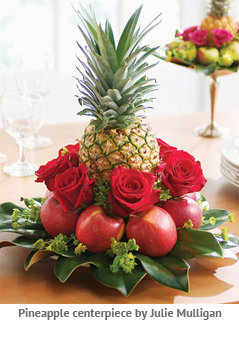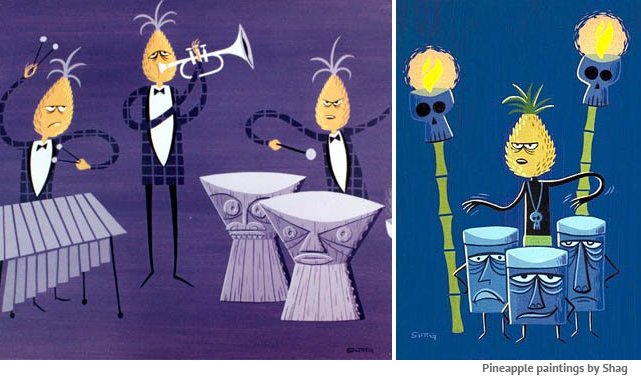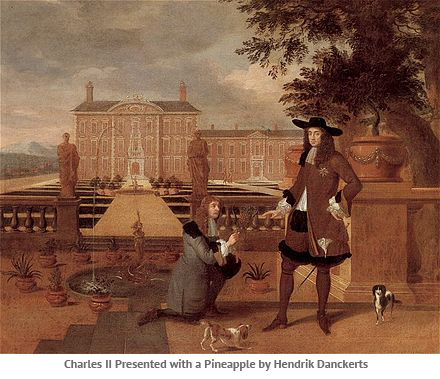For Love of the Pineapple
By Goldie Zaldivar

I absolutely adore pineapples as a delicious fruit to eat, but also the historical story behind them. Today, pineapples are featured as decorative symbols of hospitality, warmth, friendship, commitment, prosperity, family affection, aloha, and good cheer—which is why I chose a pineapple logo for Goldie Design. Another reason is because I remember seeing pineapples everywhere throughout the Carolinas while visiting my Great Aunt Goldie—who I am named after. I can still hear her southern accent calling me “Goldie Jean.”

I began placing pineapple décor in my art studio, The Pineapple Lounge, to remember my dear Aunt Goldie as my inspiration and name sake. A pineapple has also become a popular traditional feng shui symbol of wealth, fortune, and prosperity because the sound of the Chinese word for pineapple sounds close to “good coming your way.” Artisians continue to bake pineapple tarts and decorate with pineapple decorations to celebrate Chinese New Year. These reasons are why it only made sense to have the pineapple represent Goldie Design.
Until recently, I had no idea how much pineapple décor was out there because of its symbolism and history around the world. But where does this symbolism for a pineapple come from? From the very beginning, pineapples drew curiosity and inspiration from its exotic nature, unique shape, sweetness, and rarity.


Until the creation of the Dole Pineapple Plantation in the 20th century, fresh pineapples were extremely expensive and difficult to obtain because only a few ships were fast enough to deliver the fruit in good condition due to traveling through the hot, humid & extreme tropical weather conditions; therefore, it was considered to be a great achievement to arrive with one that wasn’t rotten. This is why pineapples became a celebrity, exotic fruit for epicureans, horticulturists, royalty, and the wealthy since they were introduced to Europe in 1493. Horticulturists tried diligently to grow the fruit outside its native tropical climate, but it could only be achieved using greenhouse methods and took 18 months to grow; therefore, bringing it back from Brazil and Paraguay is what Europeans had to do for the next hundreds of years.

The absence of a local supply and the increasing demand made the pineapple a very popular, rare and an expensive delicacy for the rich and royal privileged. In 1675, King Charles II posed for an official portrait with the Royal Gardner presenting him with the first pineapple grown in England as a gift (Charles II Presented with a Pineapple by Hendrik Danckerts). Only affluent households could afford to offer the exotic fruit to their guests, so pineapples naturally became the visual keystone to centerpieces to heighten the spirits of social events. Doors were kept closed and swung open to unveil a pineapple-topped food display. Guests presented with a pineapple as dessert or a pineapple centerpiece, felt honored by a hostess who spared no expense to ensure guests had the ultimate dining pleasure.

Pineapples showed status, which is why people went through great lengths to conceal the fact they rented a pineapple to display at their social event for a healthy price. The secretly, rented fruit elevated their rank in society for showing the ability to bring to the table such an expensive fruit for display. When whole pineapples arrived in good condition, they were sold to bake shops in large cities since the bakers knew who was having a dinner party. More affluent customers of the bake shop would later buy the same rented pineapple to not only display, but also to eat. This reason is why the crowned fruit became the high symbol of social events and became the meaning of welcome, friendship, and hospitality.
By the 18th century, the pineapple was represented in European and American architecture—especially the seaports that thrived on the West Indian trade route. This explains why you will find examples of artisan carved pineapples in stone and wood throughout many homes, estates, government buildings and churches throughout the Carolinas and the South. Pineapples and pineapple décor remain a great housewarming gift for family and friends. I hope you have enjoyed the history of pineapples. It’s exciting to have a pineapple logo represent Goldie Design after learning how it has been a universal symbol of welcome and hospitality for centuries all around the world.
Asking you to post anything pineapple-related on our Facebook, Twitter and Instagram pages. Looking forward to seeing people around the world showing their PINEAPPLE LOVE for Goldie Design. Thanks!
- Please recheck your ID.
Sources: The Welcoming Pineapple by Lynn Means on www.learn2grow.com; Symbolism of the Pineapple by Saurabha Palekar on www.buzzle.com; What does the Pineapple Symbolize? by Romilla D. for Kaviik’s Accents, 2008; The Pineapple As a Symbol of Hospitality by Beverly L. Pack ; Social History of the Pineapple by Hoag Levins; Pineapple – Symbol of Hospitality on www.TeaPartyDiva.com; The Story of the Pineapple, a Symbol of Hospitality by Chef Clyde Serda on www.ChefsBlade.monster.com






